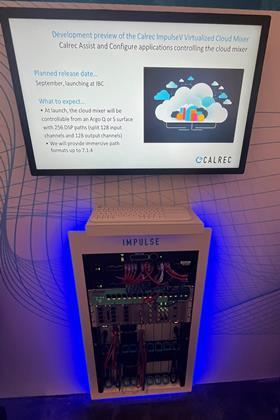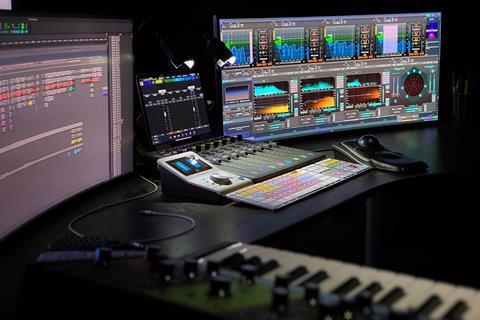The impression that broadcast audio is in the throes of an important transition – away from dedicated hardware towards virtualised systems that can support a huge variety of workflows and deliverables – is impossible to dismiss, writes David Davies.
The suggestion that professional audio – in broadcast, but equally in live music and theatre – is gradually moving away from dedicated hardware towards virtualised and, increasingly, cloud-based solutions is not a new one. But surveying the cluster of significant product launches as 2024 has unfolded, it’s become clear that the shift has decisively kicked up a gear or two.

The change is perhaps most apparent in the sphere of audio mixing, where the emphasis among multiple manufacturers is on providing efficiencies (not least through remote production), supporting encroaching virtualisation at whichever pace the customer wishes to proceed, and facilitating the kind of flexibility that means a broadcaster or service provider can deliver a huge on-site production one day – or a relatively streamlined one with technical personnel located far and wide the next.
Everything from everywhere
A sense of the pace at which audio mixing technology is currently evolving can be quickly gleaned from a look at Calrec’s recent launches, highlighted at events including NAB and the Media Production & Technology Show (MPTS). Having won Product of the Year at NAB 2023, the Argo audio mixing control platform has grown again with the introduction of a new, reduced-height variant of the Argo-S scalable IP-native mixer control surface.
Read more MPTS: British drama and production jobs under threat
Like its larger Argo siblings, Argo-S’s 12-fader-wide sections are each fully independent in terms of processing, path control access, power supplies and connectivity – meaning there is no reliance on any individual section. Hence, it maintains Argo’s “everything from everywhere” ethos of flexibility and customisation, supporting multi-user workflows in space-confined environments or as a drop-in replacement for smaller consoles.

“One of the technology changes that we’ve made for the new surface with Argo is that each section has its own system processor,” explains Henry Goodman, Calrec’s Director of Product Management. “So in itself, it’s a networkable unit and that is ‘networkable’ in the true sense, meaning it can [be part of a wider] network and processing can be controlled remotely from any location.”
Recent months have also seen Calrec introduce the Impulse1 IP audio processing and routing engine – a smaller, more cost-effective ST 2110 version of the ImPulse – and, perhaps most significantly in terms of its longer-term roadmap, preview a cloud-based audio mixer, ImpulseV, that is expected to be made commercially available around IBC in September.
Marking a further continuation of the DSP (digital signal processor)-oriented collaboration that has been taking place with fellow Audiotonix company SSL for some time, the ImpulseV has lately been the subject of “a number of proof-of-concepts, [primarily involving] smaller type of productions where they’re already using some cloud sources,” says Goodman. “One of the use cases might be that people are using playback machines which are already in the cloud, and rather than bringing those signals individually down to a console on the ground for mixing, they can use a cloud mixer to do it; effectively having a small sub-mix in the cloud for those sources and bringing down one pre-mix, as opposed to individual channels for each playback machine.”

Now that there is a good general understanding of what Goodman terms “the pinch-points for cloud” – notably, issues around latency and the type of productions that can be delivered bearing in mind the latency constraints – there is an expectation that things could move quickly. All of this leads to an inevitable query: what does the future look like for a company whose identity has historically owed much to the popularity of its hardware?
“It’s a question most manufacturers who are moving into providing cloud services or cloud software are asking themselves,” says Goodman. “I think if you look 10 or 15 years into the future, you can say that, by then, surely most audio processing is going to be done in the cloud. That said, for the foreseeable future, there are clearly some advantages to processing locally on the ground for large key events if the production team is local to those events, and it could be that sort of added production value never disappears [for some use cases]. But at the other end of the spectrum, it will enable broadcasters to start covering much lower-level sports, for example, which would not be economically viable to consider doing in a traditional sense.”
Innovating in immersive
Enabling audio professionals to deliver projects in an increasing number of formats – including surround and immersive – continues to be an overarching focus for NUGEN Audio, which introduced its new Halo Suite at NAB 2024. Ideal for immersive projects in film, TV and music, the bundle includes several of the brand’s acclaimed solutions: the Halo Vision audio analysis tool, Halo Upmix (a stereo to 5.1, 7.1 and 3D upmixer), and Halo Downmix (designed for 3D, surround and immersive audio workflows).

Freddy Vinehill-Cliffe, Product Specialist at NUGEN Audio, says that the addition of native 7.1.4 support in Halo Downmix is “our absolute latest development… Although 7.1.2 is the minimum requirement for a Dolby Atmos bed track, many of our customers in the audio post industry expect to work in 7.1.4 whenever possible. The addition of native 7.1.4 support for Halo Downmix means those customers can now access this plug-in’s powerful downmixing and surround rebalancing without compromise.”
Also surely with the demands of immersive in mind, NUGEN Audio recently released AB Assist 2 – an improved version of its A/B comparison plug-in that now supports “practically unlimited” channel counts and can receive twice as many audio sources as before – and announced the forthcoming VisLM 3 version of its popular loudness meter, which will feature new innovations “to help users manage their loudness in even faster and smarter ways than before”.

Providing insight into NUGEN Audio’s R&D philosophy, Vinehill-Cliffe identifies a guiding principle: “We simply will not develop a new tool unless we are certain we can come up with our unique approach to the process. For example, we would not have released a reverb plug-in if not for our collaboration with the University of York, which allowed our Paragon plug-in to use new state-of-the-art convolution and IR resynthesis technology to marry up the realism of a true convolution reverb with the tweakability of a classic algorithmic reverb. This was something that no other reverb plug-in had been able to accomplish before.”
Home and away
The migration towards software-based, virtualised infrastructures – or, in its words, “the abstraction of broadcast and media functionality from the hardware that does the compute-heavy lifting” – is a constant theme of Lawo’s latest cycle of announcements, which include multiple developments surrounding its HOME platform for IP-based media infrastructures. For instance, HOME Apps are single-purpose applications that run on standard servers, the latest addition to which is the ultra-low-latency HOME mc² DSP app, providing an agile audio engine that can be used with mc² mixing consoles or to instantly create a virtual mixing system – such as when audio processing is required at short notice.
Read more In the mix: breaking down the complexities of esports audio
Christian Struck, Senior Product Manager Audio Infrastructure at Lawo, confirms the overriding shift away from “bespoke hardware and predefined sets of functionalities to go more in the direction of generic backend that can be utilised based on the scenario of the application, the production type it is currently used for, and – even more interesting – being tailored in the sense of how much of one type of function can it do versus how much of another type of function? By which I mean the ability to create processing instances on-demand that run on generic CPU and can be tailored in terms of the performances and what’s really needed, rather than provisioning the maximum amount of bespoke hardware to deal with requirements that a production might need.”

The ability to marshal the precise resources when – and only when – they are needed represents a “significant advantage in terms of scalability and flexibility. And since we started with HOME Apps video processing, we’ve been asked about [the availability] of a CPU-based audio processing core. Over the last 13 or 14 months we have always been clear that we would move everything that’s processing into this platform, and now there it is: broadcast-grade video and audio processing in one platform. That means customers can really maximise the utilisation of their equipment and infrastructure.”
Of course, different user groups and environments tend to adopt new technologies at contrasting rates – a situation that could become more acute during a period of profound uncertainty in areas of broadcast, especially those more dependent on traditional linear advertising. In fact, Struck emphasises that the HOME Apps based audio core is a “parallel offering… We’re not discontinuing existing products such as the A_UHD Core.”
Nonetheless, the overall direction of travel for broadcast audio – towards greater virtualisation and capacities that can be spun or down as required by individual projects, sometimes within the space of a single day – is not in doubt. And in that sense, Lawo’s latest innovations also resonate with a sector whose business patterns are becoming more unpredictable.
“It used to be the case that [in general] you were producing in a certain format and delivering in a certain format, and having dedicated equipment which deals with that,” notes Struck. “But what we see now is that customers have an increasing need to deliver various products and formats over different infrastructures with contrasting latency and bandwidth requirements, which makes the ability to have a more flexible and meaningful way of utilising your resources [more appealing]. So yes, that’s definitely the way we see things developing.”
Read more How did Johnnie Burn become an Oscar-winning Sound Designer?
























No comments yet